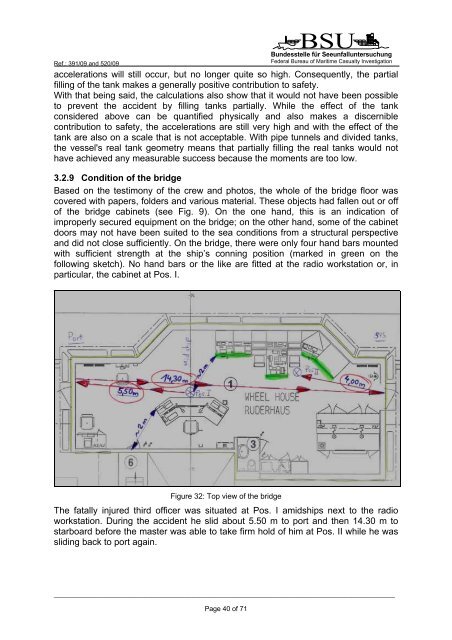SUB-COMMITTEE ON STABILITY AND LOAD LINES AND ON ...
SUB-COMMITTEE ON STABILITY AND LOAD LINES AND ON ...
SUB-COMMITTEE ON STABILITY AND LOAD LINES AND ON ...
Create successful ePaper yourself
Turn your PDF publications into a flip-book with our unique Google optimized e-Paper software.
Ref.: 391/09 and 520/09<br />
BSU<br />
Bundesstelle für Seeunfalluntersuchung<br />
Federal Bureau of Maritime Casualty Investigation<br />
accelerations will still occur, but no longer quite so high. Consequently, the partial<br />
filling of the tank makes a generally positive contribution to safety.<br />
With that being said, the calculations also show that it would not have been possible<br />
to prevent the accident by filling tanks partially. While the effect of the tank<br />
considered above can be quantified physically and also makes a discernible<br />
contribution to safety, the accelerations are still very high and with the effect of the<br />
tank are also on a scale that is not acceptable. With pipe tunnels and divided tanks,<br />
the vessel's real tank geometry means that partially filling the real tanks would not<br />
have achieved any measurable success because the moments are too low.<br />
3.2.9 Condition of the bridge<br />
Based on the testimony of the crew and photos, the whole of the bridge floor was<br />
covered with papers, folders and various material. These objects had fallen out or off<br />
of the bridge cabinets (see Fig. 9). On the one hand, this is an indication of<br />
improperly secured equipment on the bridge; on the other hand, some of the cabinet<br />
doors may not have been suited to the sea conditions from a structural perspective<br />
and did not close sufficiently. On the bridge, there were only four hand bars mounted<br />
with sufficient strength at the ship’s conning position (marked in green on the<br />
following sketch). No hand bars or the like are fitted at the radio workstation or, in<br />
particular, the cabinet at Pos. I.<br />
Figure 32: Top view of the bridge<br />
The fatally injured third officer was situated at Pos. I amidships next to the radio<br />
workstation. During the accident he slid about 5.50 m to port and then 14.30 m to<br />
starboard before the master was able to take firm hold of him at Pos. II while he was<br />
sliding back to port again.<br />
_____________________________________________________________________________________________________<br />
Page 40 of 71
















